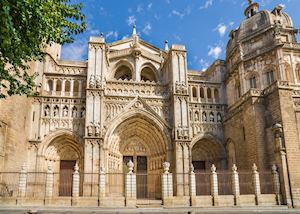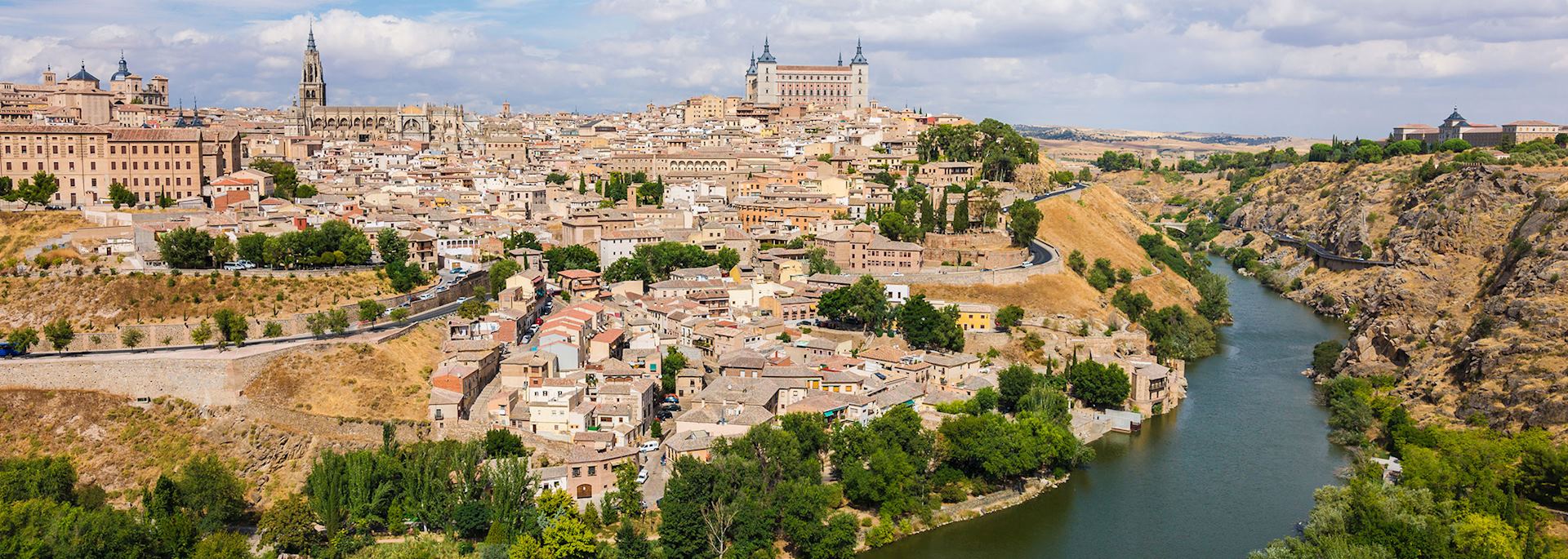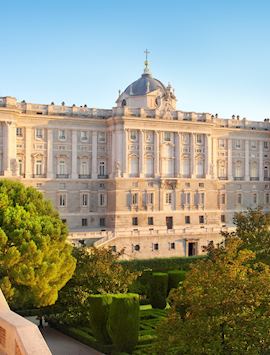Jump to:
The historic capital of Spain, Toledo was for a long time a crossroads of Europe. Romans, Visigoths, Moors, Christians and Jews have all lived here, creating a complex city whose layers of history and culture remain visible today. The city is so well preserved that it has been declared a UNESCO World Heritage Site. Set high on a stony hill that’s moated on three sides by the Tagus River, Toledo was easy to defend, making it a strategic linchpin. Armies and empires that wanted to control the region made it their stronghold, from the pre-Roman Celts to the loyalist militias during the Spanish Civil War.
Compact and located just an hour southwest of Madrid, Toledo is easy to visit in just one day. Wandering through the medieval tangle of cobbled lanes, you’ll find a Gothic cathedral, a Moorish-inspired synagogue and a 1,000-year-old mosque, as well as art by El Greco, a master of the Spanish Renaissance. Unsurprisingly, the city is dominated by a looming fortress — the Alcázar. The name comes from the Arabic word for castle, al-qasr, and reflects the building’s 10th-century Moorish origins, though it has been altered by those who came after, especially King Carlos I in the 16th century.
Spain & Portugal specialist AllanI love Toledo for its history — it’s home to the most symbolically significant building in Spain. Santa María la Blanca was a synagogue built in the Mudéjar style, which was later converted into a church.
Things to see and do in Toledo
Toledo Cathedral
 Founded in 1226, the Catedral de Toledo remains the seat and symbol of the Catholic Church’s power in Spain. Built from stone and brick, with asymmetrical towers, its façade is a hodgepodge of styles, including Renaissance, High Gothic and Mudéjar (a uniquely Iberian style influenced by Moorish principles of design).
Founded in 1226, the Catedral de Toledo remains the seat and symbol of the Catholic Church’s power in Spain. Built from stone and brick, with asymmetrical towers, its façade is a hodgepodge of styles, including Renaissance, High Gothic and Mudéjar (a uniquely Iberian style influenced by Moorish principles of design).
Its interior is a forest of pillars, illuminated by stained-glass rose windows. Artistic wonders fill the space, including a gilded altarpiece that stretches up to the ceiling and tells the story of Christ’s life in painted wooden sculptures.
Standing higher than a tall man can reach and encrusted with jewels and finely wrought sculptures is a monstrance (vessel used to display holy objects) known as La Gran Ostensoria de Toledo. Closely resembling a Gothic chapel made from precious metals, it’s said to contain the first gold that Columbus brought back from the New World.
Many of these artistic treasures are simply crammed together, displayed with little thought to context or lighting. This is especially true in the sacristy, where you can squint through the gloom to see masterpieces by the likes of El Greco, Zurbarán, Caravaggio, Titian and Raphael. The upper levels of the cloisters and the bell tower offer views over the historic heart of the city.
Church of Santo Tomé
Tucked into the Jewish Quarter, this unassuming 14th-century church is the home of El Greco’s best-known painting, El entierro del conde de Orgaz (The burial of the Count of Orgaz).
According to local legend, the Count of Orgaz was so holy that, when he died, two saints descended from Heaven to lower his body into its grave. The monumental painting that depicts this miracle demonstrates El Greco’s signature style. The ethereal top half shows Orgaz’s wispy soul being lifted to Heaven, and the more earthly lower half depicts an array of subdued, black-clad dignitaries at the funeral. Look for the artist himself staring out from the crowd. Large tour groups sometimes invade the small space, so we suggest visiting early.
San Juan de los Reyes Monastery
Located in the heart of the Jewish Quarter, this imposing brick monastery was originally intended to be a mausoleum for King Fernando and Queen Isabella as well as a symbol of Christian supremacy. When the monarchs chose to be buried at Granada instead, it was turned into a Franciscan friary.
Though it was damaged by Napoleon’s forces, it became a working monastery again in 1954. The dual-level cloisters, which spotlight the monastery’s graceful blend of Flamboyant Gothic and Mudéjar architecture, are a highlight of a visit. You can gaze at a courtyard garden from between elaborately carved columns, which are resplendent with multifoils and a menagerie worth of gargoyles.
Mezquita del Cristo de la Luz
For much of Toledo’s history, its population included Jews, Muslims and Christians. This fact is reflected in the diversity of holy places that once dotted the city, including ten mosques and ten synagogues. Today, only one historic mosque survives. Originally called Mezquita Bab-al-Mardum, it dates back to 1,000 AD and it remains largely unchanged, despite a latter-day conversion into a Christian church.
The mosque is small and square, with a brick exterior that sports triple-arched entrances on three sides. Four columns divide the interior into nine vaulted bays, each marked by its own pattern created by the criss-crossing ribs in the ceilings. The geometric designs echo the motifs found in traditional Islamic tiles.
Synagogue El Tránsito and Sephardic Museum
Spain was home to one of the world’s largest Jewish populations until the Alhambra Decree in 1492, when they were expelled. Toledo’s Sephardic Museum helps to uncover and preserve that culture with exhibits that explore Judaism’s history through archaeological finds and ceremonial objects.
The bulk of the museum is the Synagogue El Tránsito. Built as a private temple in 1355, it was one of the most important synagogues that occupied the Jewish Quarter. Today, you come to admire the Moorish-influenced stuccos, Hebrew inscriptions and carved wooden ceiling of the main prayer hall.
A short walk away, the Synagogue of Santa María la Blanca was built in 1180, making it arguably the oldest synagogue in Europe. Constructed under a Christian ruler, it was designed by Islamic architects in the Mudéjar style. Inside, the five naves are divided by rows of horseshoe arches topped with capitals carved with tight, intricate spiral ornaments.
Set high on a stony hill that’s moated on three sides by the Tagus River, Toledo was easy to defend, making it a strategic linchpin. Armies and empires that wanted to control the region made it their stronghold, from the pre-Roman Celts to the loyalist militias during the Spanish Civil War.
Unsurprisingly, the city is dominated by a looming fortress — the Alcázar. The name comes from the Arabic word for castle, al-qasr, and reflects the building’s 10th-century Moorish origins, though it has been altered by those who came after, especially King Carlos I in the 16th century.
Best time to visit Toledo
We suggest visiting from September to November or March to May, when you’ll likely enjoy dry, warm days that average around 15°C (59°F). In winter (December to February), you’ll have cooler temperatures and the occasional shower, but the sites are quieter. July and August bring hot days and thick crowds. Additionally, many Madrileños leave the city for their own summer trips and some restaurants and shops close.
who's been there
-
01993 838 92501993 838 081
- Make an enquiry
Suggested itinerary featuring Toledo
This sample itinerary will give you an idea of what is possible when you travel in Toledo, and showcases routes we know work particularly well. Treat this as inspiration, because your trip will be created uniquely by one of our specialists.
Places near Toledo
- Madrid 43 miles away
- El Escorial & Valle de los Ca铆dos 51 miles away
- 脕惫颈濒补 66 miles away
- Segovia 76 miles away
- Salamanca 116 miles away
- 颁贸谤诲辞产补 143 miles away
- Granada 187 miles away
- La Rioja 197 miles away
- Seville 202 miles away
- Andalusia 202 miles away
- Costa del Sol 219 miles away
- Ronda 224 miles away
- Bilbao 243 miles away
- The Basque Country and La Rioja 245 miles away
- San Sebasti谩n 262 miles away
- Ibiza 300 miles away


